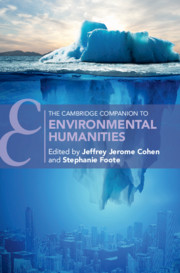Book contents
- The Cambridge Companion to Environmental Humanities
- The Cambridge Companion to Environmental Humanities
- Copyright page
- Contents
- Notes on Contributors
- Acknowledgments
- Chronology
- Chapter 1 Introduction: Climate Change/Changing Climates
- Chapter 2 The Commons
- Chapter 3 Rights
- Chapter 4 Time as Kinship
- Chapter 5 The Nature of Gender
- Chapter 6 Race, Health, and Environment
- Chapter 7 Narrative and Environmental Innovation
- Chapter 8 Climate Fictions: Future-Making Technologies
- Chapter 9 Apocalypse/Extinction
- Chapter 10 Multispecies
- Chapter 11 Food
- Chapter 12 Plants
- Chapter 13 Extraction
- Chapter 14 Ice/Water/Vapor
- Chapter 15 Rocks
- Chapter 16 Coal/Oil
- Chapter 17 Waste
- Chapter 18 Ecomedia
- Chapter 19 New Materialism and the Nonhuman Story
- Chapter 20 Risk
- Chapter 21 Coda: Virus
- Bibliography
- Index
- Cambridge Companions To Literature
- References
Chapter 19 - New Materialism and the Nonhuman Story
Published online by Cambridge University Press: 12 August 2021
- The Cambridge Companion to Environmental Humanities
- The Cambridge Companion to Environmental Humanities
- Copyright page
- Contents
- Notes on Contributors
- Acknowledgments
- Chronology
- Chapter 1 Introduction: Climate Change/Changing Climates
- Chapter 2 The Commons
- Chapter 3 Rights
- Chapter 4 Time as Kinship
- Chapter 5 The Nature of Gender
- Chapter 6 Race, Health, and Environment
- Chapter 7 Narrative and Environmental Innovation
- Chapter 8 Climate Fictions: Future-Making Technologies
- Chapter 9 Apocalypse/Extinction
- Chapter 10 Multispecies
- Chapter 11 Food
- Chapter 12 Plants
- Chapter 13 Extraction
- Chapter 14 Ice/Water/Vapor
- Chapter 15 Rocks
- Chapter 16 Coal/Oil
- Chapter 17 Waste
- Chapter 18 Ecomedia
- Chapter 19 New Materialism and the Nonhuman Story
- Chapter 20 Risk
- Chapter 21 Coda: Virus
- Bibliography
- Index
- Cambridge Companions To Literature
- References
Summary
Ecomedia studies refers to the discipline within the environmental humanities that examines the way media systems and artifacts are embedded in ecological relationships. In one sense, the media in ecomedia designates the tools of mass communication already associated with the term. But ecomedia studies insists that media are not just text, image, and sound transmitted through machines, not just the technologies of transmission, but the social and material relationships that make transmission possible. As opposed to the older discipline of media studies, "ecomedia" understands these relationships as a kind of agency beyond the immediate cultural purposes of mediated content. Ecomedia is also distinct from the older concept of media ecologies, which employs ecology as a metaphor for the way media embed themselves in social systems and coproduce social relationships. One may analyze the media ecology of Instagram as an agent of selfie production, but unless that analysis includes an understanding of Instagram's ecological effects, it is not an ecomedia analysis. In its emphasis on the materiality and agency of media in the biosphere, ecomedia studies distinguishes itself as an aspect of environmental humanism's drive beyond a merely human world.
Keywords
- Type
- Chapter
- Information
- The Cambridge Companion to Environmental Humanities , pp. 258 - 272Publisher: Cambridge University PressPrint publication year: 2021
References
Further Reading
- 2
- Cited by

